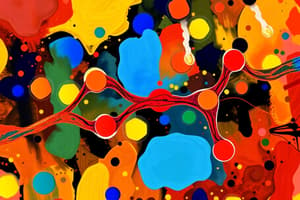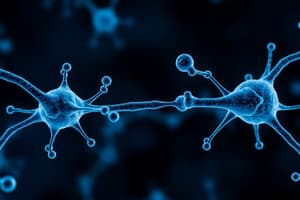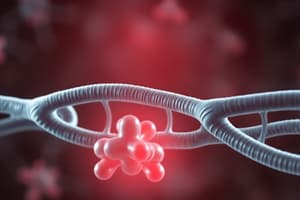Podcast
Questions and Answers
What does intrinsic activity refer to in pharmacology?
What does intrinsic activity refer to in pharmacology?
- The ability of a drug to produce action after binding to a receptor (correct)
- The amount of drug administered
- The time it takes for a drug to take effect
- The ability of a drug to bind to a receptor
Which type of drug has the highest intrinsic activity?
Which type of drug has the highest intrinsic activity?
- Partial Agonist
- Antagonist
- Inverse Agonist
- Agonist (correct)
What defines an inverse agonist?
What defines an inverse agonist?
- It produces action similar to an agonist
- It produces an opposite action to that of an agonist (correct)
- It has the same effect as an antagonist
- It enhances the effects of other drugs
What is the intrinsic activity of a drug classified as a partial agonist?
What is the intrinsic activity of a drug classified as a partial agonist?
Which statement is true regarding antagonists?
Which statement is true regarding antagonists?
Flashcards are hidden until you start studying
Study Notes
Drug Binding and Action
- Affinity refers to a drug's ability to bind to a receptor, which is crucial for its function.
- Intrinsic activity indicates a drug's capability to produce a biological effect once it binds to a receptor.
Drug Classification Based on Intrinsic Activity
- Agonist: Drugs that bind to receptors and activate them, producing a maximum response (+1).
- Partial Agonist: Drugs that bind to receptors and activate them but produce a less than maximum response (between 0 and +1).
- Inverse Agonist: Drugs that bind to receptors and induce an opposite effect compared to agonists (-ve).
- Antagonist: Drugs that do not activate receptors but block or interfere with the action of agonists, having no intrinsic activity themselves (0).
Summary of Intrinsic Activities
- Maximum intrinsic activity (Agonist): Full response achieved when binding.
- Submaximum intrinsic activity (Partial Agonist): Weaker response compared to full agonists.
- Opposite action (Inverse Agonist): Reverses the effects of agonists.
- No intrinsic action (Antagonist): Prevents receptor activation without direct activation.
Studying That Suits You
Use AI to generate personalized quizzes and flashcards to suit your learning preferences.



